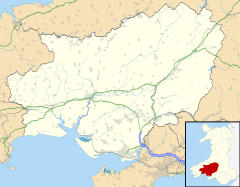Llangyndeyrn () is a village, community and electoral ward in the River Gwendraeth valley, Carmarthenshire, in Dyfed region of West Wales, United Kingdom. The village name is often spelt as Llangendeirne.
| Llangyndeyrn | |
|---|---|
Location within Carmarthenshire | |
| Population | 3,102 [1] |
| OS grid reference | SN457140 |
| Community |
|
| Principal area | |
| Preserved county | |
| Country | Wales |
| Sovereign state | United Kingdom |
| Post town | LLANELLI |
| Postcode district | SA15 |
| Post town | KIDWELLY |
| Postcode district | SA17 |
| Dialling code | 01269 |
| Police | Dyfed-Powys |
| Fire | Mid and West Wales |
| Ambulance | Welsh |
| UK Parliament | |
| Senedd Cymru – Welsh Parliament | |

The Welsh language name of the village means "the church of St. Cyndeyrn". A Welsh saint named Cyndeyrn is the equivalent of the English Kentigern and the Scottish St. Mungo; but the St Cyndeyrn associated with Llangyndeyrn is believed to be a different one, a descendant of Cunedda whose festival is on 5/6 August.
Both St Cyndeyrn's parish church and Capel Salem are grade II* listed buildings.[2] Nearby is the remains of Banc y Betws, or Betws Castle, a motte-and-bailey castle.
The small village is well known for its resistance against the attempt to flood the village in order to create a reservoir for the Borough of Swansea.
Within the village is the Ysgol Y Fro school for infants.
The community is bordered by the communities of: Llangunnor; Llanddarog; Pontyberem; Llanelli Rural; Trimsaran; Kidwelly; and Llandyfaelog, all being in Carmarthenshire and includes the villages of Pontyates, Carway and Meinciau.
Governance
editLlangyndeyrn is also a county electoral ward to Carmarthenshire County Council. The ward is coterminous with the community. The ward is represented by one county councillor.[3]
References
edit- ^ "Community and Ward populations 2011". Retrieved 16 April 2015.
- ^ "Listed Buildings in Llangyndeyrn, , Wales". British Listed Buildings. Retrieved 20 December 2013.
- ^ "The County of Carmarthenshire (Electoral Arrangements) Order 1998". Legislation.gov.uk. 23 November 1998. Retrieved 24 July 2022.

